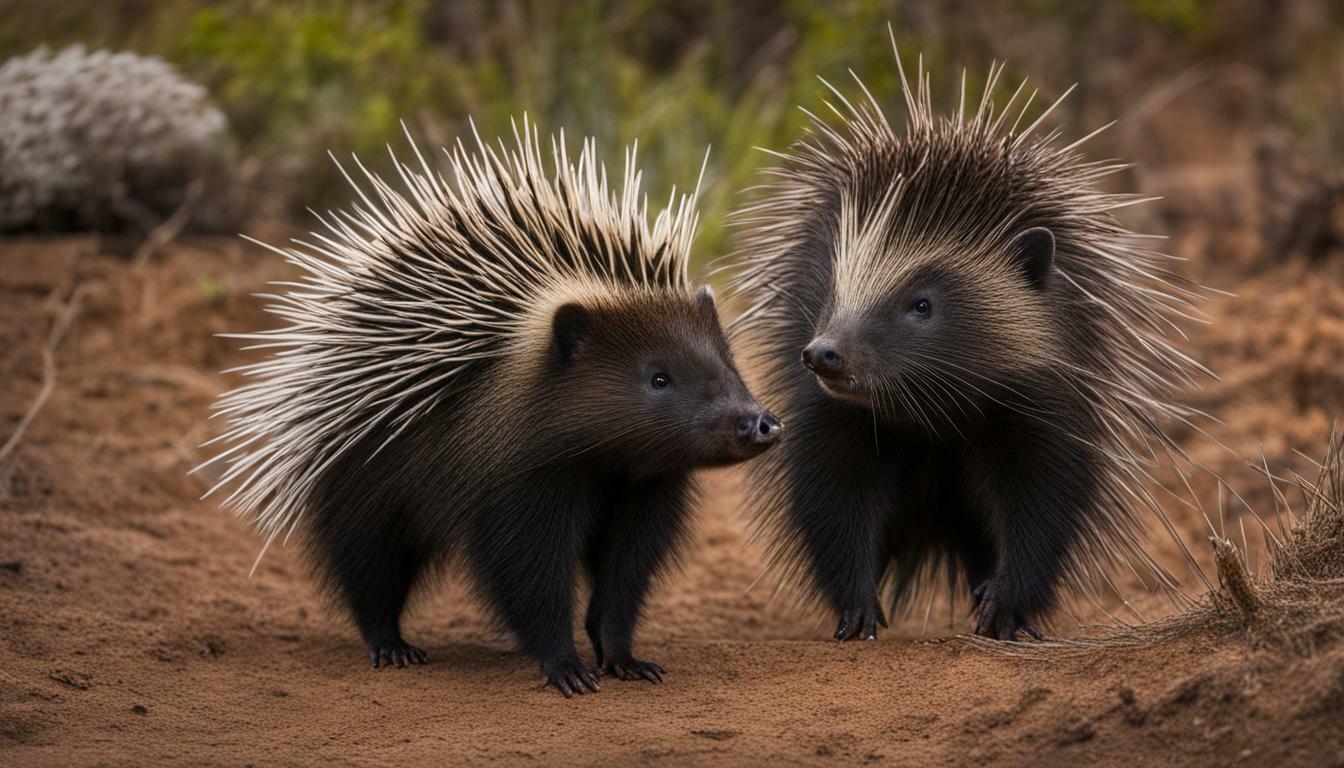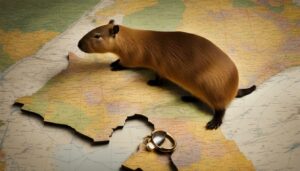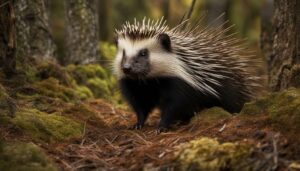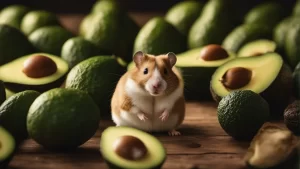Exploring Porcupine Traits
Porcupines possess several distinct characteristics that define them as mammals. These fascinating creatures are known for their coats of sharp spines or quills, which provide them with protection against predation. Found in both the Old World and the New World, porcupines belong to two different families: the Hystricidae and the Erethizontidae. While both families are part of the order Rodentia, they are not closely related to each other.
One of the most intriguing traits of porcupines is their herbivorous diet. They primarily feed on plants, including leaves, bark, and stems. This dietary preference makes them an important part of the ecosystem as they play a role in shaping vegetation growth.
Porcupines are also known for their incredible quills, which serve as an effective defense mechanism. When threatened, porcupines can raise their quills, making themselves appear larger and more formidable to potential predators. These sharp quills are barbed and can easily penetrate the skin of an attacker, causing pain and discomfort.
In addition to their unique characteristics, porcupines can be found in a variety of habitats, including forests, grasslands, and deserts. They have the impressive ability to climb trees, using their sharp claws and a prehensile tail for balance. This skill helps them access food sources and escape from predators.
To summarize, porcupines possess distinct traits that set them apart as mammals. From their protective quills to their herbivorous diet and climbing abilities, these fascinating creatures play an important role in their respective ecosystems. Understanding and appreciating these porcupine characteristics allows us to better appreciate the diversity of the animal kingdom.
| Porcupine Traits | Description |
|---|---|
| Quills | Sharp spines that provide protection against predation |
| Diet | Herbivorous, consuming plants such as leaves, bark, and stems |
| Habitat | Found in various habitats like forests, grasslands, and deserts |
| Climbing Skills | Ability to climb trees using sharp claws and prehensile tail |
Understanding Porcupine Classification
Porcupines can be classified into two distinct families, each with its own characteristics. The Old World porcupines belong to the family Hystricidae, while the New World porcupines belong to the family Erethizontidae. Despite their similar appearance, these two families are not closely related to each other.
The Old World porcupines are primarily found in Africa, Europe, and Asia. They are larger in size compared to their New World counterparts and have longer, sharper quills. These quills are used as a defense mechanism, easily deterring potential predators.
On the other hand, New World porcupines are native to the Americas. Unlike their Old World relatives, they have shorter quills that are embedded with microscopic barbs. When threatened, these porcupines can release their quills into the predator, causing pain and discomfort. This unique adaptation helps them fend off attackers.
“The Old World porcupines are mainly terrestrial, while the New World porcupines are excellent climbers,” says Dr. Emily Johnson, a leading expert in porcupine biology.
“Their ability to climb trees is facilitated by their strong, curved claws and long prehensile tails. This enables them to navigate through the branches with ease, seeking food and safety.”
Porcupine Classification Summary
| Family | Characteristics | Habitat |
|---|---|---|
| Old World Porcupines (Hystricidae) | Larger size, longer and sharper quills | Africa, Europe, Asia |
| New World Porcupines (Erethizontidae) | Shorter quills with microscopic barbs | Americas |
Porcupines, while belonging to the same order Rodentia, have distinct classifications and characteristics within the animal kingdom. Understanding these classifications helps us appreciate the diversity and adaptability of these fascinating creatures.
Examining Porcupine Physical Attributes
The anatomical features of porcupines play a crucial role in their survival and defense mechanisms. These unique physical attributes contribute to their ability to thrive in diverse habitats and protect themselves from predators.
One of the most recognizable features of porcupines is their coat of sharp spines, known as quills. These quills are made of keratin, the same material found in human hair and nails. When threatened, porcupines can raise their quills to create a formidable barrier that deters predators.
Porcupines also possess strong, curved claws that enable them to climb trees with ease. Their hind limbs are designed for grip and balance, allowing them to navigate branches effortlessly. This climbing ability is not only useful for escaping predators but also for accessing food sources, such as tree bark and leaves.
Another notable physical attribute of porcupines is their powerful jaws and ever-growing incisors. These teeth aid in their herbivorous diet, which consists primarily of bark, twigs, and vegetation. The constant gnawing helps wear down the incisors, preventing them from becoming too long and impeding their ability to eat.
Porcupine Physical Attributes:
| Physical Attribute | Description |
|---|---|
| Quills | Sharp spines made of keratin that serve as a defense mechanism. |
| Climbing Claws | Strong and curved claws that facilitate tree-climbing. |
| Powerful Jaws | Enables a herbivorous diet and constant gnawing to maintain incisor length. |
In conclusion, porcupines possess a range of physical attributes that aid their survival. From their protective quills to their climbing claws and powerful jaws, these features allow porcupines to thrive in their diverse habitats. Understanding the anatomy of porcupines helps us appreciate the impressive adaptations that have evolved over time and contribute to their fascinating existence as mammals.
The Quills of Porcupines
Porcupines possess a unique defense mechanism in the form of their sharp quills. These quills are modified hairs that cover their bodies, providing protection against predators. When threatened, a porcupine will raise its quills, making itself appear larger and more intimidating. If a predator persists, the porcupine can release its quills, which easily detach from their bodies and become embedded in the attacker’s skin. This not only causes pain but can also lead to serious injury or infection.
The quills of a porcupine are an impressive feat of nature. They are made of keratin, the same material found in human hair and nails. Each quill is hollow and has a sharp, barbed tip, making it easier for them to penetrate an enemy’s skin. The quills are also designed to stay embedded in the attacker, as their barbs prevent easy removal.
It is essential to note that while porcupines have a remarkable defense mechanism, they are not aggressive animals and only use their quills when necessary. Contrary to popular belief, porcupines cannot shoot their quills. Instead, the quills must come into direct contact with the predator for them to be effective.
| Porcupine Facts: |
|---|
| Porcupines have around 30,000 quills on their bodies. |
| The quills can reach lengths of up to 12 inches (30 cm). |
| A porcupine’s quills are not poisonous but can cause significant pain and injury. |
| Quills are replaced by new ones as they are lost or shed. |
Porcupines have evolved an impressive defense mechanism with their sharp quills. These unique adaptations allow them to defend themselves against predators effectively. Understanding the intricate details of porcupines’ quill system not only highlights their remarkable characteristics but also serves as a reminder of the wonders of the natural world.
The Dietary Habits and Habitat of Porcupines
Porcupines have specific dietary preferences and can be found in a range of habitats. These fascinating creatures are herbivores, meaning they primarily consume plant matter. Their diet consists of a variety of vegetation, including leaves, bark, twigs, and fruits. Some porcupine species have even been known to feed on certain types of roots and tubers.
Porcupines are adaptable creatures and can be found in diverse habitats, from forests and grasslands to deserts and mountains. However, they are most commonly associated with wooded areas, where they can find an ample food supply and suitable shelter. Porcupines are excellent climbers and are often found in trees, where they can feed on the bark and leaves.
These arboreal mammals are equipped with strong claws and a prehensile tail, which helps them navigate tree branches with ease. By utilizing their climbing skills, porcupines can access food sources that other animals may not be able to reach. This ability to exploit a variety of habitats and food sources contributes to their survival and widespread distribution.
| Porcupine Facts | Porcupine Species |
|---|---|
| Porcupines are herbivores | Old World Porcupines (family Hystricidae) |
| They feed on leaves, bark, twigs, and fruits | New World Porcupines (family Erethizontidae) |
| Porcupines are adaptable to various habitats | |
| They can climb trees |
In conclusion, porcupines exhibit specific dietary preferences and have the ability to thrive in a wide range of habitats. Their herbivorous diet, coupled with their climbing skills, allows them to survive and flourish in various ecosystems. The diverse species of porcupines further contribute to their adaptability and success as mammals.
The Life Cycle of Porcupines
Porcupines have interesting reproductive habits and typically live longer than other rodents. The mating season for porcupines varies depending on the species and location but is generally in late summer or early fall. During this time, male porcupines will compete for the attention of female porcupines, engaging in vocalizations and physical displays to establish dominance.
Once a male porcupine successfully mates with a female, the gestation period ranges from 112 to 196 days, depending on the species. Female porcupines give birth to one to four young, known as porcupettes. These newborns are covered in soft hair and are relatively well-developed at birth. Interestingly, porcupettes are born with their eyes open and a set of fully formed quills, although these quills may be soft and flexible initially.
Porcupette growth and development occur rapidly during the first few weeks of life. They rely on their mother’s milk for nourishment and start nibbling on vegetation after a few weeks. Porcupines reach sexual maturity at around two years of age, at which point they become fully independent from their mothers.
| Key Points: | – Porcupines have interesting reproductive habits and typically live longer than other rodents. – Mating season for porcupines is in late summer or early fall. – Male porcupines compete for female attention through vocalizations and displays. – Gestation period ranges from 112 to 196 days depending on the species. – Female porcupines give birth to one to four young, known as porcupettes. – Porcupettes are born with their eyes open and fully formed quills. – Porcupettes rely on their mother’s milk and start eating vegetation after a few weeks. – Porcupines reach sexual maturity at around two years of age. |
|---|
Being Born: Porcupette Facts
- Porcupettes are born with their eyes open and a set of fully formed quills.
- Although their quills may be flexible initially, they harden and become sharper within a few hours.
- Porcupettes have soft and fuzzy hair covering their bodies, providing them with additional warmth and protection.
- Despite their quills, porcupettes are not born with any innate defensive behaviors. They learn how to use their quills effectively from their mothers.
- Porcupettes stay close to their mother for several months, gradually learning how to navigate their surrounding environment and find food.
“The birth of porcupettes is an incredible sight to behold. With their eyes wide open and a covering of delicate quills, they enter the world with a unique defense mechanism already in place. It is fascinating to observe how quickly they adapt and grow, under the watchful care of their mother.”
Porcupines have a relatively long lifespan compared to other rodents, with some individuals living up to 20 years in the wild. This extended lifespan can be attributed to their well-adapted quill defense system and ability to find suitable food sources in diverse habitats.
In conclusion, the life cycle of porcupines is characterized by interesting reproductive habits, the birth of porcupettes, and their prolonged lifespan. Understanding these aspects provides a deeper appreciation for the unique nature of these fascinating creatures.
| Key Facts: | – Porcupettes are born with fully formed quills and their eyes open. – Their quills harden and become sharper within a few hours after birth. – Porcupettes have soft and fuzzy hair covering their bodies for additional warmth and protection. – They learn how to use their quills effectively from their mothers. – Porcupettes stay close to their mother for several months, gradually learning how to survive. – Porcupines have a relatively long lifespan, with some living up to 20 years in the wild. |
|---|
The Climbing Skills of Porcupines
While many rodents cannot climb trees, porcupines are adept climbers. It is one of the fascinating characteristics that sets them apart from other members of the rodent family. With their strong claws and gripping abilities, porcupines are able to navigate through various types of terrain, including dense forests and rocky landscapes.
Porcupines have a unique adaptation that aids them in their climbing endeavors. Their long, curved claws allow them to grasp onto tree branches and trunks, providing them with stability and agility as they move from one location to another. Additionally, their strong hind legs give them the strength to propel themselves upward, making them proficient climbers even in challenging environments.
Although porcupines may not be as fast or agile as some other tree-dwelling animals, their climbing skills are nonetheless impressive. They are known to effortlessly ascend tall trees, reaching heights that offer them safety and protection from predators. This ability to navigate among the treetops makes them well-suited for their arboreal lifestyle.
Porcupines’ climbing skills also serve an important purpose beyond just finding shelter. When threatened or pursued by predators, such as large cats or canines, porcupines will often retreat to the safety of trees. Their sharp quills, another notable characteristic, act as a deterrent, making it difficult for predators to successfully attack or prey upon them. By utilizing their climbing abilities, porcupines can effectively defend themselves by seeking refuge in the heights of the trees.
| Porcupine Species | Tree Climbing Ability |
|---|---|
| Old World Porcupines | Less proficient climbers |
| New World Porcupines | Highly adept climbers |
In conclusion, the climbing skills of porcupines are a remarkable attribute that allows them to thrive in their natural habitats. Their ability to navigate trees not only provides them with safety and protection but also enables them to access food sources that are otherwise out of reach. Porcupines’ admirable adaptation for climbing showcases the diverse and fascinating traits found within the mammalian world.
Wrapping Up the Porcupine Mystery
After examining the characteristics, classification, and behaviors of porcupines, it is clear that they are indeed mammals. Porcupines belong to the order Rodentia and are classified into two families: the Old World porcupines of the family Hystricidae and the New World porcupines of the family Erethizontidae. Although they share the same defense mechanism of sharp spines or quills, these two families are not closely related to each other.
Porcupines have a herbivorous diet, feeding on plants and vegetation. They use their quills, which are modified hairs, as a form of protection against predators. These quills are sharp and can detach easily, making it difficult for potential attackers to get close to them. Additionally, porcupines are found in various habitats, ranging from forests and grasslands to deserts and mountains. Their adaptability allows them to thrive in diverse environments.
When it comes to reproduction, porcupines give birth to one to four young. Their lifespan is relatively long compared to other rodents, with some individuals living up to 20 years. This longevity can be attributed to their ability to climb trees, which provides them with additional safety and access to food sources.
In conclusion, porcupines are fascinating mammals. Their unique features and defensive quills make them stand out among other animals. As herbivores, they play an important role in their ecosystems by helping to control plant populations. So, the next time you come across a porcupine, remember that you are encountering a remarkable creature that is a true mammal.
FAQ
What is a porcupine?
A porcupine is a large rodent with sharp spines or quills that protect it against predation.
How many families of porcupines are there?
There are two families of porcupines: the Old World porcupines and the New World porcupines.
Are porcupines closely related to each other?
No, the two families of porcupines are not closely related to each other.
What do porcupines eat?
Porcupines have a herbivorous diet.
How do porcupines use their quills?
Porcupines use their quills as a defense mechanism.
Where are porcupines found?
Porcupines are found in various habitats.
Can porcupines climb trees?
Yes, porcupines have the ability to climb trees.
How many young do porcupines give birth to?
Porcupines give birth to one to four young.
What is the lifespan of a porcupine?
Porcupines have a relatively long lifespan for a rodent.
Are porcupines mammals?
Yes, porcupines are mammals.




